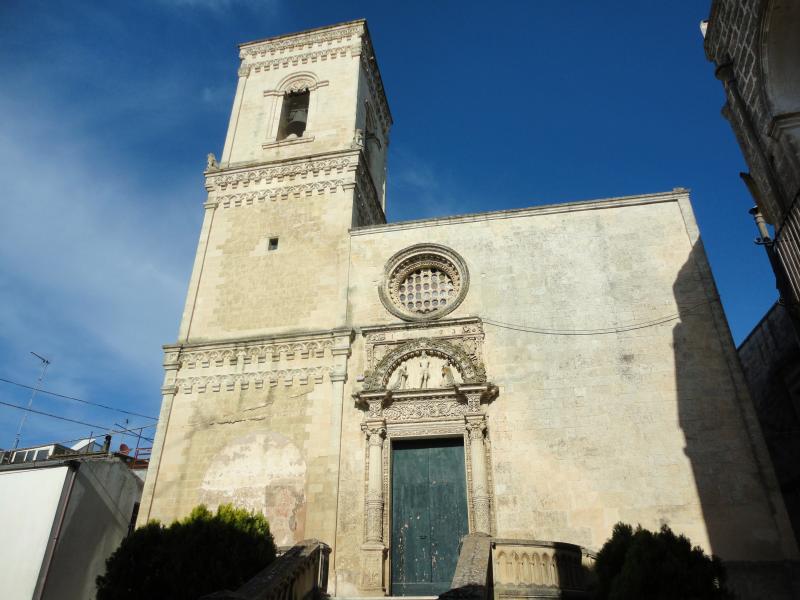San Nicola Vescovo, Corigliano D'Otranto, Lecce (Puglia). Image in the public domain.
Little is known of the construction of San Nicola Vescovo, the main church at Corigliano D'Otranto in Lecce. We know the church was finished in 1573, as this date is inscribed on its portal seemingly by architect and sculptor Gabriele Licciardi. The church appears as a simple block of local stone flanked to the right by a tower that was originally part of the city wall and served as an observation tower. The façade’s main features are the portal over the door and a circular window on top, both richly carved. The plan of the church is a Latin cross, with a nave, two side aisles, and short transepts. Each pillar along the nave is made of four Ionic columns, the barrel vault above it springs from carved corbels. A figure in one of the corbels can be identified as an architect by the characteristic three-pointed hat carved on it. Since this corbel has also been attributed to Licciardi, we can presume that Licciardi, of whom we know very little, was involved at least in the last stages of the construction of the church at Corigliano.
There are three different types of vaults covering the different parts of the building. The central nave has a cannon vault with gable windows, reminiscent of those Palladio built for San Giorgio Maggiore in Venice in 1565. The transept and the crossing are covered with star vaults or Lecce vaults, a type of construction with a long tradition in the region. Finally, the vault over the apse is a hybrid between a star vault and a barrel vault. The differences between the vaults is of interest since they seem to reflect different building campaigns and therefore the involvement of different architects in their construction. The vault over the nave, with its Renaissance references, including the carved corbels, may be part of Licciardi's intervention towards the end of the construction. The transept vaults appear to be an older part of the church or a part left to local builders. The vault over the apse reflects the importance given to the ceiling of this part of the building in sixteenth-century Puglia, where architects demonstrated their classicist background in the design of their vaults. This last vault is the most intriguing of the three since its shape departs from classical models and seems to incorporate local traditions.
When thinking about the transference of knowledge involved in the construction of vaults, we need to consider that stereotomy treatises were first published in the second half of the sixteenth century. While it is possible that manuscript copies circulated earlier, the vaults rely on the practical knowledge on the person applying its principles. In contrast to elements such as columns and carvings, which can easily be copied from a plate, building a vault requires knowledge of the properties of local stones as well as techniques for cutting complex shapes. Puglia was a place with a long-standing tradition of stone vaults. Architects who imported ideas from Spain, Italy or France in the fifteenth and sixteenth centuries brought with them the ideals of the Renaissance and workers capable of producing vaults, who would have shared their knowledge and the work with local stonemasons.
Puglia was a place of cultural exchange and in the construction of churches the cultural background of patrons and architects met with those of builders and churchgoers. In Puglia, Spanish patrons arrived from the Peninsula and from France with some monastic orders such as the Celestines who built Santa Croce in Lecce. Architects arriving to work in Puglia came from Catalonia, Majorca, Lombardy or Venice. We also know of Dalmatian architects working in Puglia, such as Francesco da Sabenico, who oversaw important works and, on many occasions, brought with them skilled workers. When considering the cultural background of the people for whom these buildings were made, we have to include the Greek origin and Byzantine background of the Pugliese, their Angevin past, the influx of Spaniards that arrived from the fifteenth century and the many passersby that came to the Adriatic coast as part of the crusades, on their way to the Holy Land or as a result of commercial endeavors.
San Nicolo Vescovo is not the only church where vaults tell the history of its construction. When looking at San Nicola a Cursi or the Chiesa Madre in Minervino (both attributed to Licciardi and very close geographically to Corigliano) we see the importance of Renaissance vaults in the design of apses next to vaults constructed in the local tradition. Traditionally in Puglia, both churches and vernacular architecture display an exceptional skill in the construction of sophisticated vaults. Looking at the history of the construction of the vaults in these examples can help us understand the cultural complexity and the technological exchange taking place in Puglia in the sixteenth century.
October 2, 2019
Bibliography
Abbate, Tomaso, and Mirco Cannella. “Matrici geometriche nelle absidi salentine del XVI secolo delle chiese di San Nicola a Cursi e di San Michele Archangelo a Minervino di Lecce.” In L’Abside: costruzione e geometrie/The Apse: Construction and Geometry, edited by Marco Rosario Nobile and Domenico Sutera, 21–40. Palermo: Caracol, 2015.
Bianchi, Vito, Clara Gelao, and Lino Patruno. Bari, la Puglia e Venezia. Bari: M. Adda, 2013.
Cadilhac, Rossella De, ed. L’arte della costruzione in pietra: Chiese di Puglia con cupole in asse dal secolo XI al XVI. Rome: Gangemi, 2008.
Fallacara, Giuseppe. “The Lecce Vault: History, Construction Techniques, and New Design Perspectives.” In Nuts and Bolts of Construction History: Culture, Technology and Society, edited by Robert Carvais, André Guillerme, Valérie Nègre, and Joël Sakarovitch. Paris: Picard, 2012. 3:99-105.
Gelao, Clara. Puglia rinascimentale. Bari: Edipuglia, 2005.
Grossman, Heather E. "On Memory, Transmission and the Practice of Building in the Crusader Mediterranean." In Mechanisms of Exchange: Transmission in Medieval Art and Architecture of the Mediterranean, ca. 1000 - 1500, edited by Heather E. Grossman and Alicia Walker, 183–219. Leiden: Brill, 2013.
Nobile, Marco Rosario. “Rinascimento alla francese: Gabriele Licciardo, architettura e costruzione nel Salento della metà del Cinquecento.” Artigrama 30 (2015): 193–219.
Oppenheimer, Michael. The Monuments of Italy: A Regional Survey of Art, Architecture and Archaeology from Classical to Modern Times. Vol. 5, Southern Italy: The Regions of Abruzzo-Molise, Campania, Puglia, Basilicata, Calabria, Sicilia and Sardegna. London and New York: Tauris, 2002.
Sanabria, Sergio Luis. “From Gothic to Renaissance Stereotomy: The Design Methods of Philibert de l’Orme and Alonso de Vandelvira.” Technology and Culture 30, no. 2 (2017): 266–99.
Navarro Morales, Maria Elisa. “Church of San Nicola Vescovo, Corigliano D’Otranto, Lecce.” In Michael Cole and Alessandra Russo, eds. Spanish Italy & the Iberian Americas. New York, NY: Columbia University, 2019. <https://doi.org/10.7916/812P-GX93>


